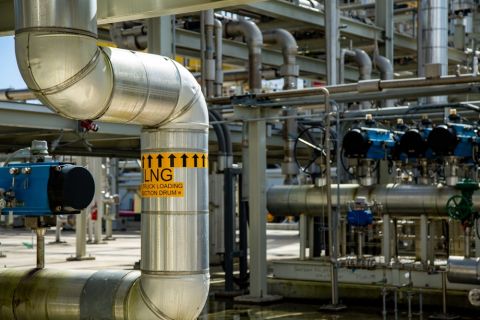Emergency evacuations arise because of many causes and under many circumstances, not all of which can be foreseen.
The effectiveness of the response can be a function of the different scenarios that operators are prepared for and the range of evacuation options available.
A recent report on managing major incident risks released by the International Oil and Gas Producers Association emphasizes the importance of effective emergency responses. A key objective is to avoid significant incidents escalating into major incidents. To achieve that goal, emergency evacuations require integrated, cross-discipline coordination and a portfolio of evacuation options.
From past to present
History can be a very good teacher. A personal experience on a platform in the central North Sea, for example, was eye-opening. An emergency muster alarm woke the crew in the early hours of the morning. Realizing this was a genuine emergency, the crew donned lifejackets and made its way quickly to the lifeboat station. Overhead, an enormous fire was engulfing the upper deck of the platform — burning crude oil from a ruptured flare line was being discharged over the entire top level.
In a conversation just a few days before, the platform manager had mentioned his reluctance to launch lifeboats due to the inherent hazards. That
conversation was far from encouraging in the face of impending evacuation. Fortunately, due to the swift response of the fire crews and a courageous process engineer, the situation was brought under control, and the crew did not have to abandon the platform. Disaster was averted for the time being, but the seriousness of the dilemma remained. If the lifeboats weren’t considered to be safe, how would the crew be removed from danger in the future?
On another occasion, a team managing a deepwater gas blowout in the Mediterranean Sea that lasted for days worked under circumstances that dictated helicopters could not be used. The most reasonable alternative was to use a crane to transfer personnel. This solution allowed the job to run with a skeleton crew throughout the operation. All of the off-duty personnel were transferred by crane onto support vessels, a precaution that left fewer people immediately at risk and set the stage for a more manageable full evacuation, should it have become necessary.
The value of using a crane to transfer personnel had become obvious.
The difference between a significant incident (i.e., a “near miss” or an un-ignited release of hydrocarbons) and a major incident can come down to the effectiveness of the emergency response.
The Piper Alpha incident in the North Sea, the Temsah platform emergency offshore Egypt in 2004, and the Mumbai High situation that cost the lives of crew members offshore India in 2006 are all examples of events in which major hydrocarbon releases were ignited. The resulting loss of life varied considerably, in part due to the effectiveness of the emergency response.
Many emergency operations around the world have benefited from strategic deployment of crane transfers, and the method has saved many lives. In 2001, before Petrobras’ P-36 floating production platform sank offshore Brazil, 128 people were evacuated to safety by crane, with the remaining 24 people being evacuated by helicopter. This is a clear demonstration of the importance of having a range of options at the operator’s disposal.
Changing the face of personnel evacuation
Evacuation is rarely a simple issue, and situations vary considerably. When an emergency situation develops, it is normally unexpected. There are few other common factors among emergency situations. Causes, scenarios, and the required responses vary greatly.
Two things are clear from the frequency of incidents within the industry. One is that it is unrealistic to identify all risks and emergency scenarios. The other is that, despite efforts to manage risk, major incidents will continue to occur.
It is critical to have emergency response provisions in place to mitigate the effects of a minor incident before it escalates into a major one and to respond to a major incident as quickly as possible should it occur. Such provisions should be an integral part of the safety management system and should be recognized as an important means of preventing major incidents.
Traditionally, a number of personnel evacuation methods have been used to remove the crew from potential harm: wet evacuation methods, including life rafts or escaping to the sea using life jackets; and dry evacuation methods, which include lifeboats, helicopters, and crane transfer.
Different evacuation methods offer different advantages and different limitations. Some methods are quick for a small number of people but aren’t practical for a large crew.
Some solutions are fast to implement but do not work well under certain weather conditions. Still others are suitable for precautionary evacuations, while others are only viable options when the entire crew is under extreme risk.
Depending on the scenario, crane-based personnel transfers could offer important advantages over other evacuation methods for a number of reasons:
• The method is immediately available and under the control of the platform manager;
• The process is fully reversible, so it is easier to initiate down-manning;
• It is ideal for evacuating large numbers of personnel;
• Crews can be transferred directly to a safe refuge;
• Evacuations can be performed in weather conditions unsuitable for helicopter operations, such as thick fog and high winds; and
• It is very safe when properly performed with the correct equipment.
Crane transfers remain a viable option for emergency evacuation. History has told us that crane transfers warrant a central role in offshore evacuation strategies. Every emergency operation should be undertaken in an integrated way. That means it is important to give consideration to the whole system, including vessels, cranes, transfer devices, and operational controls.
As part of the emergency evacuation portfolio, crane transfers should be practiced along with other emergency procedures to ensure that they can be used effectively in a real emergency.
Recommended Reading
U.S. Shale-catters to IPO Australian Shale Explorer on NYSE
2024-05-04 - Tamboran Resources Corp. is majority owned by Permian wildcatter Bryan Sheffield and chaired by Haynesville and Eagle Ford discovery co-leader Dick Stoneburner.
PrairieSky Adds $6.4MM in Mannville Royalty Interests, Reduces Debt
2024-04-23 - PrairieSky Royalty said the acquisition was funded with excess earnings from the CA$83 million (US$60.75 million) generated from operations.
JMR Services, A-Plus P&A to Merge Companies
2024-03-05 - The combined organization will operate under JMR Services and aims to become the largest pure-play plug and abandonment company in the nation.
New Fortress Energy Sells Two Power Plants to Puerto Rico
2024-03-18 - New Fortress Energy sold two power plants to the Puerto Rico Electric Power Authority to provide cleaner and lower cost energy to the island.
Kimmeridge Fast Forwards on SilverBow with Takeover Bid
2024-03-13 - Investment firm Kimmeridge Energy Management, which first asked for additional SilverBow Resources board seats, has followed up with a buyout offer. A deal would make a nearly 1 Bcfe/d Eagle Ford pureplay.





